The Jersey Giant chicken is the largest chicken breed in the world. With large bodies and good egg laying abilities, Jersey Giants can supply the meat and egg laying needs for your homestead. They aren’t a common breed. However, these gentle chickens make a good addition for hobby farmers looking for a dual purpose breed.
Jersey Giant hens lay up to 200 extra large eggs per year, making them very productive. If you are considering raising Jersey Giants to sell for meat, they may not be as profitable as other meat breeds. This is because they take longer to reach butcher weight. Also, due to their large size, they eat more than smaller breeds.
Therefore, the return on investment may not be as high. This is why they aren’t typically grown commercially as a meat bird. If they will be free ranging, however, this may not be as big of an issue for backyard hobby farms.
These are giant chickens! Jersey Giants are considered to be the largest chicken breed in the world. Jersey Giant hens weigh 10 – 12 pounds and roosters can weigh 15 pounds. Coming in second to the Jersey Giant chicken in weight is the Brahma chicken.
Jersey Giant Chicken History
Originally, the goal was to create a chicken breed for meat to rival turkeys. In the later part of the 1800s, John and Thomas Black of Burlington County, New Jersey decided to attempt to breed a chicken that could replace the turkey, the primary source of poultry consumed at the time.
They crossed Dark Brahmas, Black Langshans, and Black Javas. This careful breeding created a large, heavy bodied bird that was used in the meat industry as capons for a time.
The original name of these birds was the Black Giant, after the men who created the breed. Eventually, the breed of chicken was named Jersey Giants after the state in which they were created. In the 1920s, the Jersey Giant chicken began to be exported to places like the United Kingdom.
Varieties
The original breeders were more concerned with the size of the Jersey Giant than with color. Because of this, the birds come in a variety of feather patterns and colors. Purebred Jersey Giants come in three official colors. They are:
- Black
- White
- Blue
The black color was the original coloration that the Black brothers created. You will most often find black Jersey Giants. It was recognized by the American Poultry Association (APA) in 1922. The white color was introduced in 1947. The blue color was added in 2002.
There are other colors and patterns of the Jersey Giant chicken that are not recognized by the APA. Some breeders breed speckled or splash feathered birds as well.
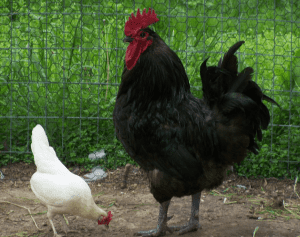
Temperament
Jersey Giant chickens are very calm and a pleasure in the barnyard. Even a Jersey Giant rooster is docile and will seldom attack his keepers. Yet, due to the large size of the roosters, they can rough up the hens when mating.
The hens and roosters are very friendly. They move slowly and are calm so the Jersey Giant may be the kind of chicken that you can pick up and cuddle. Give the chicks and young chickens special attention as you raise them, and they will become affectionate chickens that are glad to see you. They also may eat from your hand if you teach them to do so.
These chickens are good foragers, and Jersey Giants enjoy being outdoors exploring and searching for insects and worms. Allowing them to free range is ideal. The increased activity level can help with the development of muscles in your meat chickens, leading to a better carcass overall.
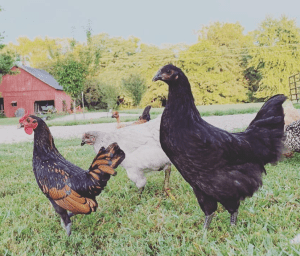
Jersey Giants also do very well in mixed flocks. Their calm nature means that they will not squabble with the other birds in the coop or pen. However, because they are so large, it is less likely that they will be picked on by other breeds of chickens too.
They do not bully other smaller chickens, and you can house them even with bantams if you provide enough space for the bantams to stay clear of the larger birds.
Hardiness
Jersey Giant chickens are very healthy chickens overall. Their lifespan is 6 – 8+ years. However, their large size makes them struggle when the weather turns hot. If you live in a place with hot summers, make sure that your Jersey Giant has plenty of space in the coop, lots of shade, and a great deal of cool, fresh water.
In winter, the Jersey Giant chicken can withstand cold temperatures. They are considered to be fairly cold hardy. However, you have to make sure that your birds have appropriate shelter and are fed enough. They have large combs which can be prone to frostbite.
It’s important they stay warm and dry. The shelter should be well-ventilated but not be drafty. See below for information about caring for this breed in the wintertime. It’s important to have a chicken watering system to protect their combs. For example, you don’t want them to dunk their heads into a bucket to drink.
Another thing to watch for when raising Jersey Giants is bumble foot. Because these birds are large, when they leap from a tall place, they can injure their feet. A cut or bruise can become infected, leading to bumble foot. If you catch bumble foot early, it is easily treated. The first sign of it is limping, so check your chickens regularly for this problem.
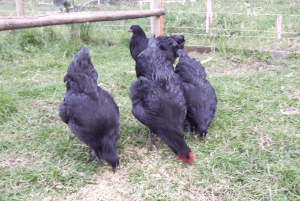
Jersey Giant Hens
Jersey Giant hens are beautiful birds. They lay huge brown eggs 2 – 4 times a week. Hens tend to go broody and can do different times of year. They make excellent mothers. However, because of their large size, these hens frequently break eggs.
Be sure that you have enough nest boxes and that they are large enough for these giant chickens. You also definitely want to ensure that your chicken nesting boxes have plenty of hay or straw in them to cushion the eggs.
Mature Jersey Giant hens can grow up to 10 pounds in weight and reach 20 inches in height.
If you buy a bantam version of the Jersey Giant, the hens will only weigh about 35 ounces.
The hens may lay a bit later than some other breeds of chickens because they take longer to reach maturity. Some chicken keepers have reported that their giant hens didn’t start laying until eight months of age. However, because of their cold hardiness, these hens tend to continue to lay even into the cold months of the year (typically at a reduced rate, however).
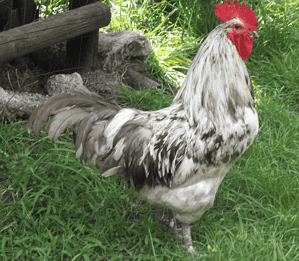
Jersey Giant Roosters
Jersey Giant roosters are massive chickens. They are about 15 pounds in weight and can grow to over 2 feet in height. If you make capons out of the roosters, they may grow up to 20 pounds in weight. Bantam roosters may weigh about 40 ounces.
However, because the roosters are so big, they may give the hens a rough time in breeding. Hens may end up with bare backs and scratches on their skin simply because the roosters are quite large. Be sure to have enough chickens per rooster. A good ratio is 7 – 10 hens per rooster.
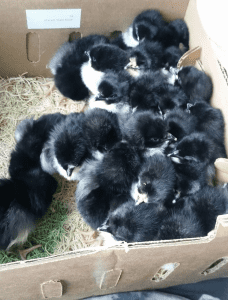
Jersey Giant Chicks
If you hatch baby chicks from a breeder or hatchery, you will see the Jersey Giant chicks are black with white patches. This American breed looks a bit like a turkey. Female chicks will cost more than male chicks. The price for unsexed chicks will be less than females and more than males.
In time, you can hatch Jersey Giants from your own flock to increase your flock size.
As the chicks mature into chickens, there will still be some white feathering. By 6 months, they will typically be all black.
Appearance
As noted above, Jersey Giants come in black, white, or blue, and sometimes “splash.” Their feathers lie close to the body, so the chickens have a very tidy appearance. They have short tails and clean legs. Their bodies are wide and deep, and they have straight backs.
Black Jersey Giants have iridescent blue-black feathering. This plumage gives the Jersey Giant a lustrous sheen. Interestingly, Black Jersey Giants grow somewhat larger than those of other colors. Black is the most common color. If you see a giant black chicken, it may be a Jersey Giant!
Jersey Giants have bright red single combs, earlobes, and wattles, and they have brown eyes. Their beaks are black with yellowish tinges around the tips. Most Jersey Giants have gray colored legs with yellow feet. However, some colors have black legs.
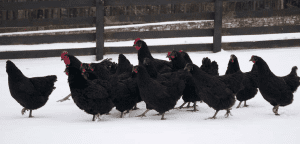
Care
Jersey Giants need pretty much the same things that other chickens need, just on a larger scale. You have to feed these chickens a lot more than other breeds, so make sure that you are not skimping on rations. If you have the Jersey Giant chicken in a mixed flock, have several feeding stations so that the Jersey Giant can get adequate food.
Even if you free range them, you will still need to provide plenty of chicken feed.
Make sure that there is enough space in your coop and in your pen for the Jersey Giant. Consider doorways and entryways as well. You may not be able to keep as many of this breed of chickens as other, smaller breeds.
With this large chicken breed especially, it is important to know how much space chickens need. Enough space will keep all the chickens happier and minimize stress.
If you are raising Jersey Giants, you may want to adjust the height of your chickens’ food and water dispensers. It is best to keep these dishes at about back height.
Additionally, Jersey Giants’ large single combs may need special care in winter. As with all chickens with single combs, the combs are more prone to frostbite in bitterly cold weather. You may want to provide a bit of supplemental heat if the weather is supposed to stay below freezing for more than a few days.
Also, avoid pail-type waterers when it is cold since these kinds of water arrangements can lead to your Jersey Giant rooster having a wet comb, which may become frostbitten.
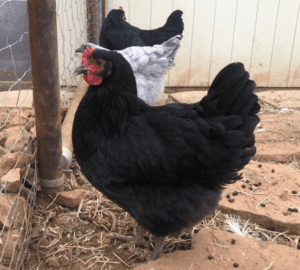
Purpose for Raising Jersey Giants
The Jersey Giant is a dual purpose breed, however, it was originally bred for meat. Even though they are slow to mature, they are considered one of the best meat chickens for their huge size.
Jersey Giant Chicken Meat
They grow to be enormous birds that are a good size for the table. Because of their calm, laid back natures, the meat is generally tender and juicy.
However, Jersey Giants do grow very slowly, especially when compared to other meat breeds like the Cornish Rock. Their feed-to-meat conversion rate is very low in comparison to many other meat breeds. Therefore, if you are looking for a high return on investment, raising Jersey Giants may not be ideal.
It takes the Jersey Giant about 6 – 8 months to reach butchering weight. However, one bird can easily feed a family of four when butchered.
One thing to keep in mind is that the Jersey Giant has yellow skin. If you are growing meat chickens to sell, you may want to consider that some people may find the yellow skin unappealing. However, the meat is just as good as white-skinned chicken.
Jersey Giant Chicken Eggs
Despite their large size, the Jersey Giant does lay eggs fairly well. They are known to lay more eggs compared to other large and heavy breeds. While their egg production will decrease in cold months, they are considered to be good winter layers.
Hens at maturity lay between 2 and 4 eggs per week, which translates to about 150 to 200 eggs per year. The eggs are very large and are dark brown in color. They are considered one of the best egg-laying chickens for extra large eggs.
If you are looking for a homestead chicken that lays well, is hardy and healthy, has a calm nature, and is considered a dual-purpose chicken, the Jersey Giant may be just the one.
Challenges
Jersey Giants are easy chickens to raise, but they do have a few challenges. These are mostly related to their size.
These chickens need extra space, and because of this, they may not be the best choice for those who live in cities. You need to make sure that your pens are appropriately sized, or allow the Jersey Giant to free-range. In an enclosed pen, the Jersey Giant needs about 6 to 8 square feet per bird.
Giving them space to move about will help to be healthier and not obese.
Additionally, you may need to add extra roosting space for these huge chickens. They need 15 to 18 inches of perching space per bird to avoid overcrowding.
You may also need to lower the perches or give them a ramp up to the perches. The Jersey Giant’s heavy size means that they might injure themselves leaping from high perches. Give these giant chickens a perch that is no more two feet off the ground to protect their feet and legs. Ideally, the perch will be no higher than 18 inches.
Buying Jersey Giant Chickens
Despite its early success, Jersey Giants diminished in popularity in the 1950s. Farmers and commercial chicken breeders found other meat breeds that reached maturity more quickly with lower feed costs.
Because of this loss in popularity, the Jersey Giant became more and more unusual over the following decades. Eventually, the chicken breed was listed on the Livestock Conservancy’s critically endangered list because it was so rare.
However, in the past few decades, the slow food, farm to table movement has led to increased interest in this heritage breed. Their numbers are slowly recovering thanks to more breeders and hatcheries raising the chickens.
When you buy Jersey Giant chicks, you should buy chicks from a reputable hatchery if possible. Do a search for Jersey Giant chicken to see if there are any in your area. If you are buying from a backyard breeder, be sure to check out the parent chickens. They should be comparable in size to the average sizes listed above.
Some unethical breeders will breed large black chickens and call them Jersey Giants. The chickens may never reach the proper size if they are not of good bloodlines.
Who Should Raise Jersey Giants
When deciding among the best chicken breeds, it’s important to consider your climate and our purpose for raising chickens. Jersey Giants are great chickens for beginning chicken keepers, since they are so hardy, friendly, and easy to raise. They are good birds for children too, if the kids will not be intimidated by their massive size.
If you have problems with hawks or owls preying on chickens, you may want to give Jersey Giants a try. Their enormous size means that these predatory birds are less likely to carry the Jersey Giant away. Some people who raise Jersey Giants report that these big birds stand up fairly well against dog attacks as well.
If you are interested in raising your own meat, these birds are a great choice. You can allow the chickens to slowly mature, butchering them a few at a time as you need meat for your table. The hens will provide eggs for your table and the roosters will be a great source of meat.
If you have a market for “slow food” in your community, the Jersey Giant may be a great choice for your flock. Many people like the complexity of flavor that a slower maturing chicken provides.
If you like breeding chickens, you may find a market for breeding and selling Jersey Giant chickens. Pay close attention to bloodlines and make sure that you start with the very best breeding stock.
A word of advice, though. If you are breeding these lovely chickens, you should cull the roosters that grow quickly and begin to fill out in the first six to nine months. These roosters will never reach the enormous size that the breed is notorious for. Breeders have learned that the roosters who are still lean and tall at young ages will eventually grow larger than those who fill out younger.
Giant Chicken
As the heaviest of all chicken breeds, Jersey Giant chickens can be the perfect fit for many homestead operations. Hens will provide extra large eggs throughout the year. The roosters are friendly and will protect the flock from predators.
As a heritage breed, they are a gentle, heavy breed but slower to grow and mature than other chicken breeds. If you see a giant black chicken with a green sheen or black rooster, it is likely a Jersey Giant. There are also white Jersey Giants which are less common and blue Jersey Giants with their black shanks with feathers that are slate blue with darker blue lacing.
Learn more about this Jerseys and other largest chicken breeds

